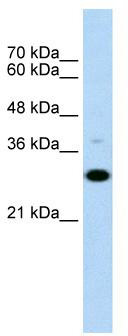CD40 Rabbit Polyclonal Antibody
Frequently bought together (2)
Transient overexpression lysate of CD40 molecule, TNF receptor superfamily member 5 (CD40), transcript variant 1
USD 396.00
Other products for "CD40"
Specifications
| Product Data | |
| Applications | WB |
| Recommended Dilution | WB |
| Reactivities | Human |
| Host | Rabbit |
| Isotype | IgG |
| Clonality | Polyclonal |
| Immunogen | The immunogen for anti-CD40 antibody: synthetic peptide directed towards the N terminal of human CD40. Synthetic peptide located within the following region: WNRETHCHQHKYCDPNLGLRVQQKGTSETDTICTCEEGWHCTSEACESCV |
| Formulation | Liquid. Purified antibody supplied in 1x PBS buffer with 0.09% (w/v) sodium azide and 2% sucrose. Note that this product is shipped as lyophilized powder to China customers. |
| Purification | Affinity Purified |
| Conjugation | Unconjugated |
| Storage | Store at -20°C as received. |
| Stability | Stable for 12 months from date of receipt. |
| Predicted Protein Size | 30 kDa |
| Gene Name | CD40 molecule |
| Database Link | |
| Background | CD40 is a member of the TNF-receptor superfamily. This receptor has been found to be essential in mediating a broad variety of immune and inflammatory responses including T cell-dependent immunoglobulin class switching, memory B cell development, and germinal center formation. AT-hook transcription factor AKNA is reported to coordinately regulate the expression of this receptor and its ligand, which may be important for homotypic cell interactions. Adaptor protein TNFR2 interacts with this receptor and serves as a mediator of the signal transduction. The interaction of this receptor and its ligand is found to be necessary for amyloid-beta-induced microglial activation, and thus is thought to be an early event in Alzheimer disease pathogenesis.The protein encoded by this gene is a member of the TNF-receptor superfamily. This receptor has been found to be essential in mediating a broad variety of immune and inflammatory responses including T cell-dependent immunoglobulin class switching, memory B cell development, and germinal center formation. AT-hook transcription factor AKNA is reported to coordinately regulate the expression of this receptor and its ligand, which may be important for homotypic cell interactions. Adaptor protein TNFR2 interacts with this receptor and serves as a mediator of the signal transduction. The interaction of this receptor and its ligand is found to be necessary for amyloid-beta-induced microglial activation, and thus is thought to be an early event in Alzheimer disease pathogenesis. Two alternatively spliced transcript variants of this gene encoding distinct isoforms have been reported. |
| Synonyms | Bp50; CDW40; p50; TNFRSF5 |
| Note | Immunogen Sequence Homology: Human: 100%; Rabbit: 79% |
| Reference Data | |
| Protein Families | Druggable Genome, Secreted Protein, Transmembrane |
| Protein Pathways | Allograft rejection, Asthma, Autoimmune thyroid disease, Cell adhesion molecules (CAMs), Cytokine-cytokine receptor interaction, Primary immunodeficiency, Systemic lupus erythematosus, Toll-like receptor signaling pathway, Viral myocarditis |
Documents
| Product Manuals |
| FAQs |
| SDS |
{0} Product Review(s)
0 Product Review(s)
Submit review
Be the first one to submit a review
Product Citations
*Delivery time may vary from web posted schedule. Occasional delays may occur due to unforeseen
complexities in the preparation of your product. International customers may expect an additional 1-2 weeks
in shipping.






























































































































































































































































 Germany
Germany
 Japan
Japan
 United Kingdom
United Kingdom
 China
China



